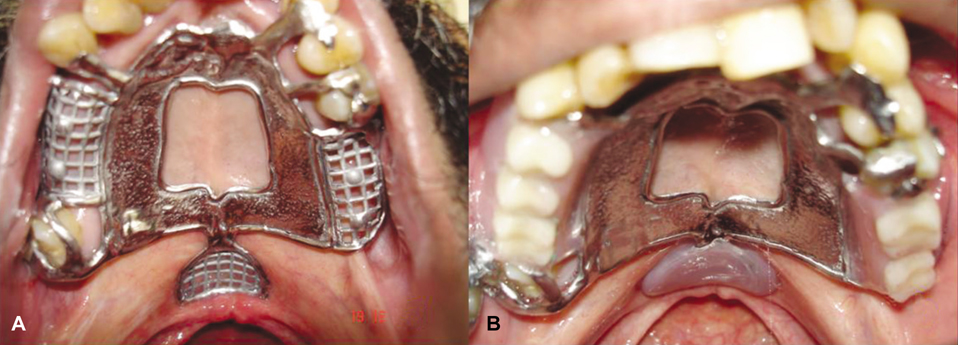J Adv Prosthodont.
2012 Nov;4(4):243-247. 10.4047/jap.2012.4.4.243.
Interim palatal lift prosthesis as a constituent of multidisciplinary approach in the treatment of velopharyngeal incompetence
- Affiliations
-
- 1Department of Prosthodontics, Saraswati Dental College and Hospital, Lucknow, Uttar Pradesh, India. neerja_gogia@yahoo.com
- 2Department of Oral Pathology, Saraswati Dental College and Hospital, Lucknow, Uttar Pradesh, India.
- 3Department of Prosthodontics, Seema Dental College and Hospital, Rishikesh, Uttarakhand, India.
- KMID: 2176425
- DOI: http://doi.org/10.4047/jap.2012.4.4.243
Abstract
- The velopharynx is a tridimensional muscular valve located between the oral and nasal cavities, consisting of the lateral and posterior pharyngeal walls and the soft palate, and controls the passage of air. Velopharyngeal insufficiency may take place when the velopharyngeal valve is unable to perform its own closing, due to a lack of tissue or lack of proper movement. Treatment options include surgical correction, prosthetic rehabilitation, and speech therapy; though optimal results often require a multidisciplinary approach for the restoration of both anatomical and physiological defect. We report a case of 56 year old male patient presenting with hypernasal speech pattern and velopharyngeal insufficiency secondary to cleft palate which had been surgically corrected 18 years ago. The patient was treated with a combination of speech therapy and palatal lift prosthesis employing interim prostheses in various phases before the insertion of definitive appliance. This phase-wise treatment plan helped to improve patient's compliance and final outcome.
Keyword
MeSH Terms
Figure
Cited by 2 articles
-
Prosthetic rehabilitation of soft palate resection edentulous patient with maxillary obturator
Seung-Beom Ryu, Seong-Joo Heo, Jai-Young Koak, Seong-Kyun Kim
J Korean Acad Prosthodont. 2019;57(4):475-482. doi: 10.4047/jkap.2019.57.4.475.Fabrication of palatal lift prosthesis for a patient with palatal defect
Hae In Jeon, Ye Chan Lee, Jung Hoon Kim, Kyu Hyung Park, In-Ho Cha, Young-Bum Park
J Korean Acad Prosthodont. 2018;56(2):161-165. doi: 10.4047/jkap.2018.56.2.161.
Reference
-
1. Curtis TA, Beumer J. Beumer J, Curtis TA, Firtell DN, editors. Speech, palatopharyngeal function, and restoration of soft palate defects. Maxillofacial Rehabilitation-Prosthodontic and Surgical Consideration. 1979. St. Louis: CV Mosby Company;244–291.2. Cotton RT, Willging JP. Bluestone CD, Stool SE, Kenna MA, editors. Velopharyngeal Insufficiency. Pediatric Otolaryngology. 1995. 3rd Edition. Philadelphia: WB Saunders Company;1621–1631.3. Pinto JH, Pegoraro-Krook MI. Evaluation of palatal prosthesis for the treatment of velopharyngeal dysfunction. J Appl Oral Sci. 2003. 11:192–197.4. Weber J Jr, Chase RA. Stress velopharyngeal incompetence in an oboe player. Cleft Palate J. 1970. 7:858–861.5. Sell D, Mars M, Worrell E. Process and outcome study of multidisciplinary prosthetic treatment for velopharyngeal dysfunction. Int J Lang Commun Disord. 2006. 41:495–511.6. Sweeney T, Sell D. Relationship between perceptual ratings of nasality and nasometry in children/adolescents with cleft palate and/or velopharyngeal dysfunction. Int J Lang Commun Disord. 2008. 43:265–282.7. Loney RW, Bloem TJ. Velopharyngeal dysfunction: recommendations for use of nomenclature. Cleft Palate J. 1987. 24:334–335.8. Witt PD, Rozelle AA, Marsh JL, Marty-Grames L, Muntz HR, Gay WD, Pilgram TK. Do palatal lift prostheses stimulate velopharyngeal neuromuscular activity? Cleft Palate Craniofac J. 1995. 32:469–475.9. La Velle WE, Hardy JC. Palatal lift prostheses for treatment of palatopharyngeal incompetence. J Prosthet Dent. 1979. 42:308–315.10. Beery QC, Rood SR, Schramm VL Jr. Pharyngeal wall motion in prosthetically managed cleft palate adults. Cleft Palate J. 1983. 20:7–17.11. Karnell MP, Rosenstein H, Fine L. Nasal videoendoscopy in prosthetic management of palatopharyngeal dysfunction. J Prosthet Dent. 1987. 58:479–484.12. Mazaheri M, Mazaheri EH. Prosthodontic aspects of palatal elevation and palatopharyngeal stimulation. J Prosthet Dent. 1976. 35:319–326.13. Hardy JC, Netsell R, Schweiger JW, Morris HL. Management of VP dysfunction in cerebral palsy. J Speech Hear Disord. 1969. 34:123–137.14. Eckert SE, Desjardins RP, Taylor TD. Taylor TD, editor. Clinical Management of the Soft Palate Defect. Clinical Maxillofacial Prosthetics. 2000. Chicago: Quintessence Publishing Co, Inc;121–131.15. Crockett DM. Healy GB, editor. Velopharyngeal incompetence. Common Problems in Pediatric Otolaryngology-Head and Neck Surgery. 1990. London: Year Book Medical Publisher;275–288.
- Full Text Links
- Actions
-
Cited
- CITED
-
- Close
- Share
- Similar articles
-
- Fabrication of palatal lift prosthesis using thermoplastic resin for a patient with velopharyngeal insufficiency
- A Clinical Study of Palatal lift for treatment of velopharyngeal incompetency
- A Case of Velopharyngeal Incompetence due to Unexplained Myopathy in a Patient with Terminal-Staged Breast Cancer
- Fabrication of palatal lift prosthesis for a patient with palatal defect
- Successful and rapid response of speech bulb reduction program combined with speech therapy in velopharyngeal dysfunction: a case report




